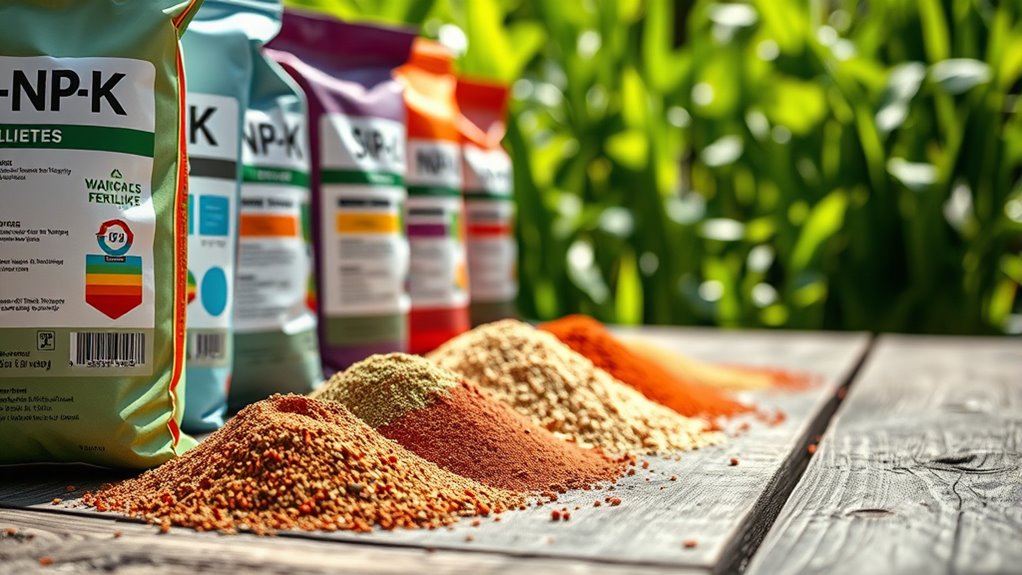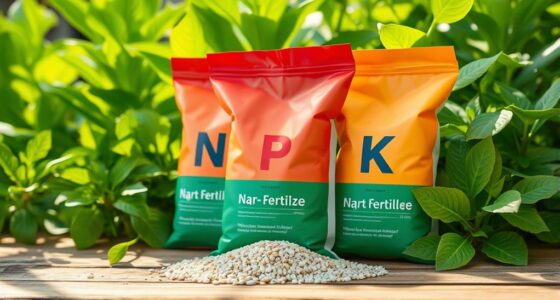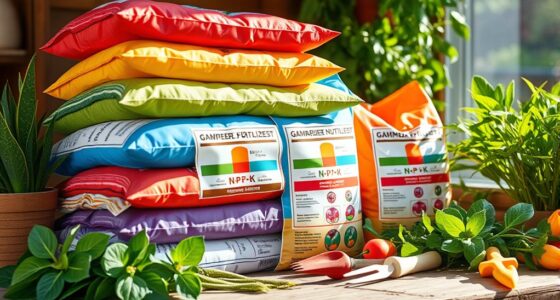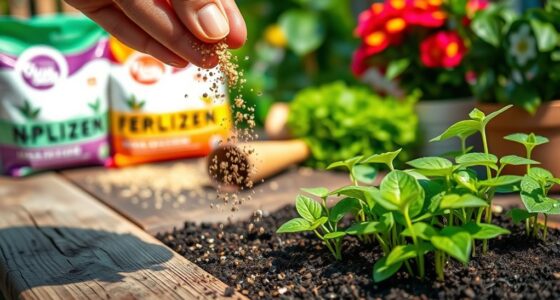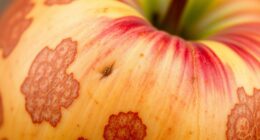To understand fertilizer, you’ll want to focus on the N-P-K ratio, which stands for nitrogen, phosphorus, and potassium—essential nutrients your plants need for healthy growth. Nitrogen promotes leafy growth, phosphorus supports roots and flowers, and potassium boosts overall plant strength. Proper fertilization depends on your soil’s condition and your plants’ needs. If you keep exploring, you’ll learn how to tailor fertilizer use for the best garden results and healthier plants.
Key Takeaways
- N-P-K ratios on fertilizer labels indicate the proportions of nitrogen, phosphorus, and potassium your plants need for healthy growth.
- Nitrogen promotes leafy green growth, phosphorus supports root development and flowering, potassium improves overall plant resilience.
- Soil testing helps determine existing nutrient levels and guides appropriate fertilizer selection and application.
- Organic fertilizers release nutrients slowly, enhancing soil health, while synthetic options provide quick nutrient availability.
- Applying the right fertilizer at the correct stage of plant growth maximizes health and minimizes environmental impact.
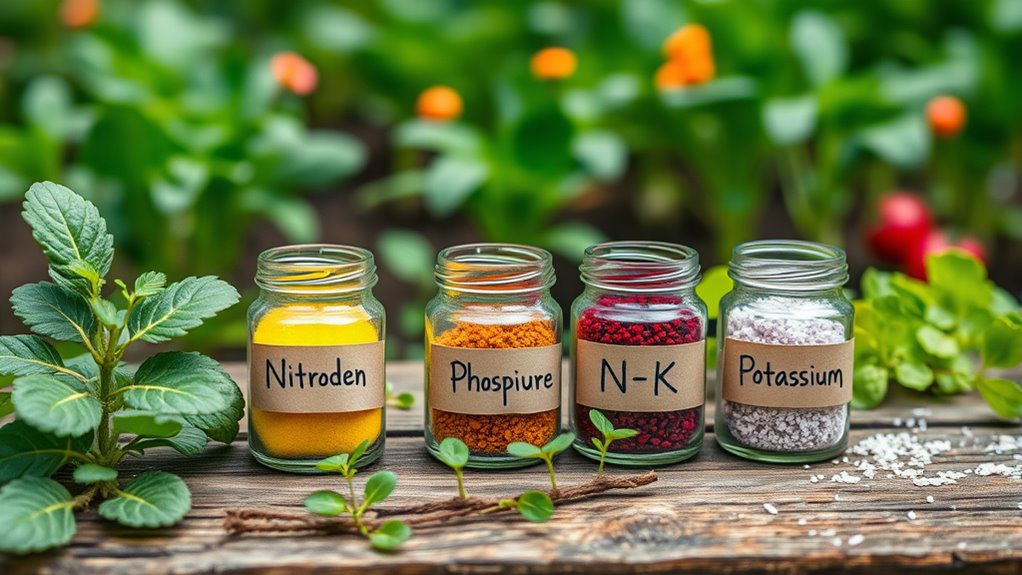
Have you ever wondered how to give your plants the nutrients they need to thrive? It all starts with understanding what fertilizers do and how to choose the right type. Fertilizers supply essential nutrients that plants require for healthy growth, and these nutrients are often represented by the N-P-K ratio on the packaging. N-P-K stands for nitrogen, phosphorus, and potassium, which are the primary elements plants need in varying amounts. But before you apply any fertilizer, it’s important to contemplate the condition of your soil. Soil amendments are a key part of this process—they improve soil structure, enhance nutrient availability, and promote plant health. Organic soil amendments like compost or manure add nutrients naturally and improve soil’s ability to retain moisture and aerate. Synthetic amendments, on the other hand, are manufactured to supply specific nutrients quickly but may not improve soil structure over the long term. Knowing when to use organic versus synthetic fertilizers depends on your goals and the condition of your soil. Organic options tend to be gentler and build soil health gradually, making them ideal for sustainable gardening. Synthetic fertilizers deliver nutrients rapidly, which can be beneficial if your plants show signs of deficiencies or if you need quick results. However, overuse of synthetic options can lead to nutrient runoff and soil degradation, so moderation is key. To decide what’s best for your garden, start with a soil test. This will tell you which nutrients are lacking or excessive and guide your choice between organic and synthetic fertilizers. If your soil is already rich in nutrients, you might only need to supplement with organic amendments like compost or natural fertilizers. If deficiencies are identified, a balanced synthetic fertilizer may provide the necessary boost. Always follow application instructions carefully to avoid overfeeding your plants, which can cause damage or excess runoff. Remember, healthy soil is the foundation of a thriving garden. Incorporating organic soil amendments can improve soil health over time, reducing your reliance on synthetic fertilizers. Conversely, using synthetic fertilizers sparingly can give plants a quick pick-me-up when needed, especially during critical growth stages. Additionally, understanding the impact of fertilizers on soil health can help you make more sustainable choices. The key is balance: understanding your soil’s needs, choosing the right type of fertilizer, and applying it appropriately. By paying attention to these details, you’ll give your plants the best chance to flourish. Whether you prefer organic methods or synthetic options, the goal is to provide your plants with consistent, appropriate nutrition. With knowledge and care, you can create a vibrant, healthy garden that’s both productive and sustainable.
Frequently Asked Questions
How Often Should I Fertilize My Plants?
You should fertilize your plants based on their specific needs and soil testing results. Typically, a monthly fertilization schedule works for most plants, but some may require more or less frequent feeding. Regular soil testing helps you determine nutrient deficiencies and adjust your fertilization schedule accordingly. Keep an eye on plant health and growth; if they show signs of stress, consider adjusting how often you apply fertilizer to keep them thriving.
Can I Over-Fertilize My Garden?
Yes, you can over-fertilize your garden, which can harm plants and soil health. To avoid this, use compost benefits as a natural fertilizer alternative, providing nutrients without risking overfeeding. Monitor your plants and follow recommended application rates. Over-fertilizing can lead to nutrient runoff and pollution, so balance your approach with organic options like compost and other natural fertilizers. This keeps your garden thriving without the risks of excess nutrients.
Are Organic Fertilizers Better Than Synthetic Ones?
Think of organic fertilizers as gentle guardians nurturing your garden’s soul, while synthetic ones can be like hurried messengers rushing nutrients. Organic benefits include enriching soil health and supporting eco-friendly practices, making your garden more resilient. Synthetic drawbacks often involve quicker nutrient release but can harm soil over time. You get the best results by choosing a balanced approach, blending organic benefits with mindful synthetic use for vibrant, healthy plants.
How Do I Choose the Right Fertilizer for My Plants?
You should consider your plants’ specific needs and soil pH when choosing fertilizer types. Test your soil first to determine pH and nutrient deficiencies. Then, select a fertilizer that matches those needs—organic options for slow release or synthetic for quick nutrients. Always follow the label instructions, and choose a formulation suitable for your plant type to promote healthy growth and avoid over-fertilizing.
What Are Signs of Nutrient Deficiencies in Plants?
You might notice your plants showing unusual signs, which often point to nutrient deficiency signs. For example, yellowing leaves can indicate nitrogen deficiency, while stunted growth might suggest lack of phosphorus. Spotting these plant symptom identification clues helps you act quickly. Keep an eye out for irregular color changes or leaf deformities. Recognizing these signs allows you to address nutrient issues early, ensuring healthier, more vibrant plants.
Conclusion
So, next time you toss some fertilizer on your plants, remember: N-P-K isn’t rocket science—though, honestly, it might be just as confusing. Don’t overthink it; your plants just want a little love (and maybe some balanced nutrients). Skip the guesswork, follow the label, and stop pretending you’re a gardening wizard. After all, if your plants could talk, they’d probably say, “Less guesswork, more growth.” Happy fertilizing!
